With two of the brightest stars of the night sky, Betelgeuse and Rigel, essentially forming the armpit and left knee or shoulder and foot, depending on how you draw, the Orion constellation is one of the most conspicuous objects scattered across the glittering starry night sky. It is pointless to track down the exact day or the particular person who first saw and recognised the Hunter in His act. Needless to say, such information is beyond obscurity. That our prehistoric ancestors were amazed by the heavens is more than evident from the cave paintings found at various sites of early human settlements scattered across the globe. Skipping all mythology and other things, I am taking the liberty to continue with astronomy.
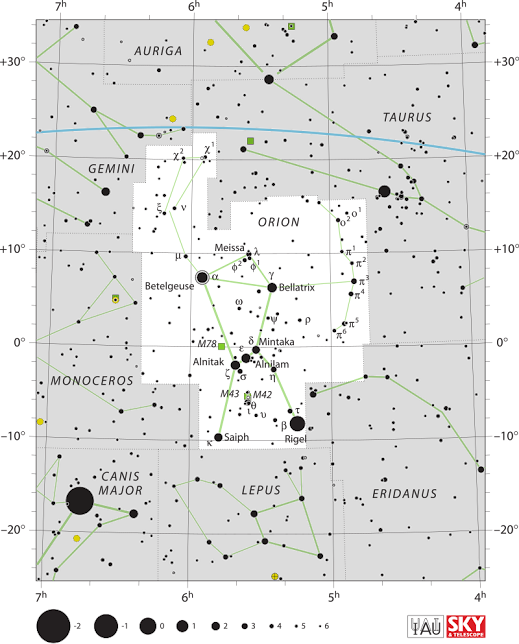 |
The star chart gives a comprehensive list of all the stars of Orion
Image Credits: Public Domain, via Wikimedia Commons
|
As per the standard astronomical designation, Betelgeuse or 𝛼 - Orionis is under the regular scanner of astronomers since this star is about to blow in a titanic supernova anytime within 100,000 years. Even if the star blows up right now, we would have no way of knowing its present status before 600 years as it is approximately 600 light years away from Earth. Betelgeuse is a massive star, almost 15 - 20 times more massive than our Sun, with a luminosity ranging between 90,000 - 150,000 times in excess. However, its enormous size does not necessarily make it a blisteringly hot star. At 3,600 K, its surface is cooler and visibly redder than the Sun. At just 10 million years old, this giant star appeared in Earth's sky when populations of African apes started their journey up the evolutionary tree of human life. Being born a giant star, Betelgeuse has sprinted rapidly through the typical evolutionary phases and has reached its end stage. It has grown so huge that if it replaced the Sun, its mean radial extent of approximately 3.6 AU would extend beyond the asteroid belt, possibly up to Jupiter, with its outer layers of ejected gas reaching out to Neptune. When this roseate star finally blows, Orion will have what can be best described as a ''blown apart'' armpit or shoulder. If humanity manages to live that long, then the Hunter, as always, will present a spectacular sight. Orion's exploded shoulder will be visible during the day, while at night, the expanding nova will match the brightness of a full moon. Even though a typical supernova can exceed the combined luminosity of all the stars in a galaxy, it does not remain bright for an extended period of time. As the ejected mass disperses away, the remnant nova will eventually dim below the naked-eye limit, and our almost immortal Hunter will be without a shoulder.
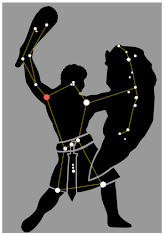 |
An artistic rendition of Orion with
His shield and club.
Image Credits: Public Domain,
via Wikimedia Commons. |
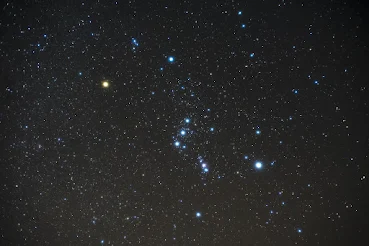 |
The Hunter in full glory.
Image Credits: Public Domain, via Needpix.com |
Rigel or 𝛽 - Orionis, which forms the Hunter's knee, is another giant star, albeit a blue supergiant. Contrary to what appears as a single blue-white point to the naked eye, Rigel is a system of four stars, of which, 𝛽 - Orionis or Rigel A, colloquially known as the ''Diamond of Orion'' is the brightest component whereas, its companions, designated as Rigel Ba, Rigel Bb and Rigel C are not so bright and are not easily visible with an ordinary telescope, let alone the unaided eye. Based on some estimates, the Rigel system can be as far as 900 light years from the Sun. The system's primary, Rigel A, has a mass of 20 - 25 solar masses, a surface temperature of around 12,000 K and a luminosity exceeding 120,000 times the Sun's average. Just like Betelgeuse, this blue supergiant is close to 8 - 9 million years old. Since the fate of all massive stars is the same, a supernova, Rigel, is also running low on hydrogen. In the future that is yet to come, both Rigel and Betelgeuse will ''set fire to the night sky''. perhaps leaving behind a black hole or a neutron star. Rigel A's companion, Rigel Ba and Bb form a binary system, with Rigel C as B's companion. They are all blue-white stars, hotter and 3 - 4 times more massive than the Sun.
Bellatrix or 𝜸- Orionis, the star on Hunter's left shoulder, is another blue-white star like Rigel, except the former is comparatively bluer. Located some 250 light years from the Sun, it is a very young star, supposed to have formed only 25 million years ago. At 7.7 solar masses, Bellatrix has an average surface temperature of 22,000 K and a luminosity 9,000 times that of the Sun.
Saiph or 𝜿 - Orionis that marks the Hunter's right knee is again a blue-white supergiant located some 650 light years away from the Sun. It is nearly 15 times massive and more than 56,800 times luminous compared to our Sun. Its surface temperature is higher than Rigel, averaging at 26,500 K. Estimated to be 11 million years old, Kappa Ori has left the main sequence and is on the path of a supernova. Even though Saiph is an Arabic word for ''sword'', looking directly at the constellation raises some confusion since the position of Kappa Ori distinctly marks Orion's foot. Formerly Saiph was the name given to 𝜼 - Orionis, a star seen between Mintaka (on Orion's belt) and Rigel, which actually forms the handle of His angelic sword.
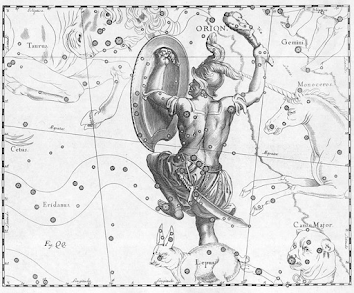 |
Another illustration of the Hunter.
Image Credits: Public Domain, via Wikimedia Commons |
𝜼 - Orionis, at 1000 light years from the Sun, is found slightly to the west below 𝛅 - Orionis and between Rigel. Spectroscopic studies reveal Eta Orionis to be a multiple-star system containing four blue-white stars. The primary, Eta Ori Aa, along with Ab and Ac, makes up a spectroscopic trinary system of which Aa is the brightest, having a luminosity 26,000 times that of the Sun and a mass 11 times greater. The companion stars are all massive, brighter and hotter than the Sun.
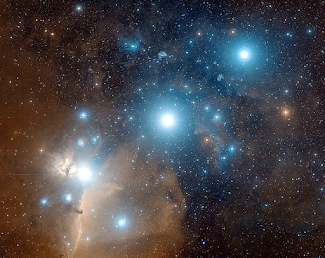 |
The Three Kings - Mintaka on the top right, Alnilam in the middle,
and Alnitak on the bottom of the same line forms the Belt.
Image Credits: Public Domain, via Wikimedia Commons |
The trio of blue-white stars that mark the Hunter's ''Belt'', namely 𝛅 - Orionis or Mintaka, 𝜺 - Orionis or Alnilam, and 𝛇 - Orionis or Alnitak, presents us an example of an asterism. Asterisms are similar to constellations in the sense that they both mean patterns in the sky, except the latter, is a more formal and official designation of star patterns based on an ancient scheme of classification that divides the night sky into distinct regions. The IAU recognises 88 constellations, including ancient (since Greek times) and modern ones. Asterisms are a general classification of star patterns.
- Mintaka is a multiple-star system located some 1,200 light years from the Sun and is one of the brightest stars visible to the naked eye. The primary companion is itself part of a trinary system. Out of the three stars, 𝛿 Ori Aa1 is 25 solar mass heavy and a luminosity approximately 190,000 greater than the Sun. 𝛿 Ori Ab is equally heavy at 22 solar masses and a luminosity 63,000 times that of the Sun. The third companion, 𝛿 Ori Aa2, is an 8 solar mass subgiant. The 𝛿 Ori system further contains another subgiant and a very dim star, raising the member strength to five.
- Alnilam is an exceptionally bright and massive blue supergiant star. At a distance of 2000 light years from the Sun, this 40 - 44 solar mass star could be 275,000 - 832,000 times more luminous than the Sun. Its surface temperature is close to 27,500 K. Alnilam is only 5.7 million years old, and being a massive star, it will rapidly consume its store of hydrogen, thereby ending its life as a violent supernova within the next few million years.
- Alnitak, without exception, is a triple-star system situated some 1,260 light distance. Alnitak Aa and Ab form a close binary in which the former is a 33 solar mass supergiant while the latter is a 14 solar mass giant star. The brightest of the two, the primary companion is 250,000 times more luminous than the Sun. The third companion's mass has not been calculated accurately, and some suggest that there might as well be a fourth companion lurking in the distance.
Before packing up, let us turn our eyes to Orion's disproportionately small head, in contrast, to the rest of His body. The Hunter's head gives us the joy of looking at an open star cluster. Generally, star clusters are of two types - tight-packing globular clusters and open clusters. A most common example of the latter kind is the well-known Pleiades cluster. More than 1,300 light-years distant and 5 million years old, the λ - Orionis or Collinder 69 open cluster involves a large number of young and bright stars, out of which, as of now, we will only look at λ - Orionis or Meissa, Phi (φ¹) Orionis and (φ²) Orionis. The brightest of the three, Meissa, forms the apex of the triangular arrangement, with Phi 1 and 2 Orionis at the base. At 30 solar masses and 165,000 times more luminous than the Sun, with a surface temperature of 35,000 K, Meissa is a blue-white supergiant star. It has a 10 solar mass binary companion. Phi 1Orionis is another spectroscopic binary situated some 1,000 light years from the Sun. Phi 2 Orionis, on the contrary, is quite similar to the Sun. It is a G-type subgiant with nearly the same mass as the Sun. At 6.9 billion years old, it is evolving away from the main and will likely explode in a supernova.
Orion is a rich constellation. Not only does it contain scores of bright, hot and young stars easily seen with the naked eye, but also involves some of the most famous and most-talked-of, namely the prominent M 42 nebula right at the tip of Orion's sword. Close to 𝜁 Orionis, one could be looking at IC 434 or the Horsehead nebula. Apart from the eight major stars I have discussed in this article, the Orion constellation includes a dozen other stars that are equally interesting. And since nebulae are nothing but stellar nurseries, the birthplace of stars, astronomers frequently turn their telescopes towards the Great Hunter of the night to record the earliest days of star formation. In the upcoming issue, we will turn our eyes to the nebulae in Orion, the Hunter's shield, sword and club, and experience the thrill of looking up at the night sky.
References:
- Motz, Lloyd, and Carol Nathanson. The Constellations: An Enthusiast's Guide to the Night Sky. Doubleday. Bantam Doubleday Dell Publishing Group Inc., New York, 1988.
- Bakich, Michael E. The Cambridge Guide to the Constellations. Cambridge University Press, 1995.
- Moore, Patrick. The Data Book of Astronomy. Institute of Physics Publishing, Bristol, UK, 2000.







Comments
Post a Comment